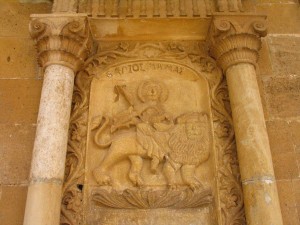Church of St. Mamas

Guzelyurt Museum of Archaeology and Natural History
3 December, 2009
Carob Warehouses
3 December, 2009
St. Mamas Church | Guzelyurt
Unless approaching Guzelyurt from the Nicosia road, it is impossible to miss this church as it is built at a central point where roads converge. Constructed during the 18th C AD, on the site of an early Byzantine church, this remains without doubt the most beautiful and best kept of all the Orthodox churches that are preserved as Icon Museums. Since the opening of the borders, a limited amount of worship has been permitted by the TRNC authorities. However the church is still maintained by the Antiquities Department of North Cyprus and is the highlight of a visit to Guzelyurt.
A strange mixture of Gothic and Byzantine styles, it is more spacious than many other Orthodox churches on the island. It has a central nave, apse, and two side aisles, with a dome that rises above the nave at the altar end, pierced by six tall, narrow windows. The columns are decorated with foliar carvings, vine leaves and some faces, in a rather heavy style, unlike carvings in other churches of similar design but of an earlier period that are carved with clearer delineation.
Into the iconostasis are incorporated marble panels that are carved with Venetian coats of arms, and there are two marble pillars on either side of the Holy Door that are evidence of early recycling, probably from an earlier church though not necessarily on this site. However there is no evidence that this church was ever in use by members of the Catholic faith and therefore presumably it has always been a place of Orthodox worship.
The most beautiful exhibit in the church is the magnificent crystal chandelier that hangs in the centre of the apse. There are hundreds of droplets that glow will all the iridescence of the spectrum when the lamps are lit, and it is flanked by smaller, though equally elegant examples of the glass-blowers craft. However they cannot compare in brilliance even if the main chandelier is not switched on! The best view is with the entrance doors wide open, though the custodian takes some persuasion to permit it.

Ay Mamas Church | Guzelyurt
This is only one of several churches on the island dedicated to St. Mamas, around whom many legends have arisen that stretch across many centuries. According to one of these legends, Mamas was a young holy man who lived in a cave outside the town limits during the Roman occupation. At that time all citizens were required to pay taxes and Mamas was no exception. However he pleaded poverty and said he had nothing but the clothes he wore and the food he was given by charitable people from the town for whom he prayed in return. This was not an acceptable plea for the Roman authorities and he was arrested. On the way into town he saw a lamb being attacked by a ferocious lion, without hesitation he scooped the lamb into his arms, jumped on the lion’s back, and continued on his way to face whatever punishment the Governor of the town was going to give him. So astounded was the court at the sight of the young man on the lion, clasping the lamb to his chest, that they believed he truly was a holy man and all punishment and exemption from taxes was granted to Mamas forthwith. Thus he has become the patron saint of tax avoiders!
There is another legend that says Mamas was killed somewhere in Anatolia and was placed by his family in a stone coffin, aided by no less a personage than Jesus Christ! The legend continues with the story that the coffin was swept away into the sea and was washed up on the shores of Guzelyurt Bay. A local farmer harnessed it to two oxen and hauled it as far as the beasts could manage, and when they could go no further, a church was built around it.
The marble sarcophagus of St. Mamas can be found forming part of the north wall of the church and over the interior a richly carved and decorated tympanum depicts scenes of excruciating martyrdom. The lid of the tomb has been pierced, again according to legend by someone who thought the tomb contained treasure, and the hole created now oozes a liquid that is purported to have curative properties. Around the tomb will be seen votive offerings in the shape of ears and tongues because St. Mamas is not only the Patron Saint of tax avoiders, but also those suffering with ear, nose and throat infections!





